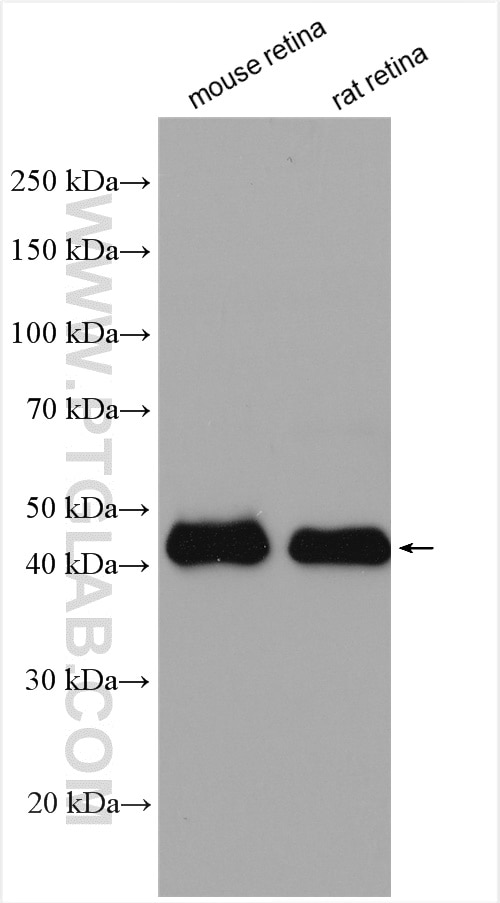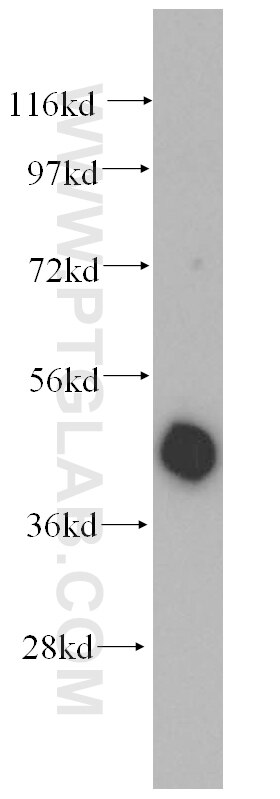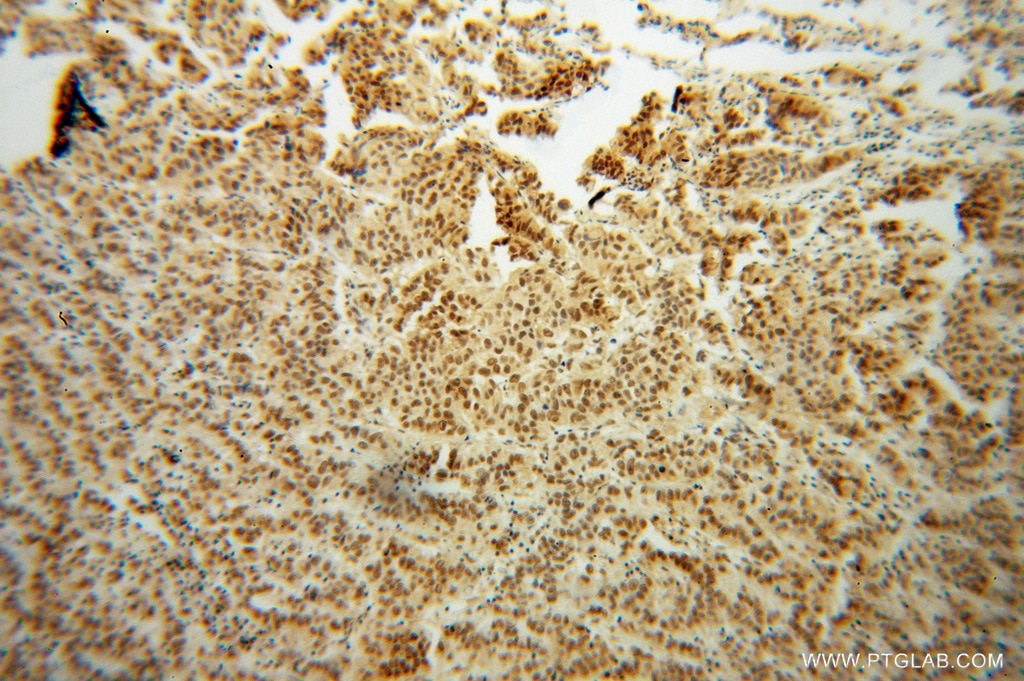- Phare
- Validé par KD/KO
Anticorps Polyclonal de lapin anti-NR2E3
NR2E3 Polyclonal Antibody for WB, IF, IHC, ELISA
Hôte / Isotype
Lapin / IgG
Réactivité testée
Humain, porc, rat, souris et plus (1)
Applications
WB, IHC, IF/ICC, ELISA
Conjugaison
Non conjugué
N° de cat : 14246-1-AP
Synonymes
Galerie de données de validation
Applications testées
| Résultats positifs en WB | tissu rétinien de souris, cellules HepG2, cellules Y79, tissu rétinien de rat |
| Résultats positifs en IHC | tissu de cancer de la prostate humain il est suggéré de démasquer l'antigène avec un tampon de TE buffer pH 9.0; (*) À défaut, 'le démasquage de l'antigène peut être 'effectué avec un tampon citrate pH 6,0. |
| Résultats positifs en IF/ICC | cellules progénitrices photoréceptrices |
Dilution recommandée
| Application | Dilution |
|---|---|
| Western Blot (WB) | WB : 1:2000-1:12000 |
| Immunohistochimie (IHC) | IHC : 1:20-1:200 |
| Immunofluorescence (IF)/ICC | IF/ICC : 1:20-1:100 |
| It is recommended that this reagent should be titrated in each testing system to obtain optimal results. | |
| Sample-dependent, check data in validation data gallery | |
Applications publiées
| KD/KO | See 1 publications below |
| WB | See 4 publications below |
| IHC | See 3 publications below |
Informations sur le produit
14246-1-AP cible NR2E3 dans les applications de WB, IHC, IF/ICC, ELISA et montre une réactivité avec des échantillons Humain, porc, rat, souris
| Réactivité | Humain, porc, rat, souris |
| Réactivité citée | Humain, poisson-zèbre, souris |
| Hôte / Isotype | Lapin / IgG |
| Clonalité | Polyclonal |
| Type | Anticorps |
| Immunogène | NR2E3 Protéine recombinante Ag5503 |
| Nom complet | nuclear receptor subfamily 2, group E, member 3 |
| Masse moléculaire calculée | 45 kDa |
| Poids moléculaire observé | 43-45 kDa |
| Numéro d’acquisition GenBank | BC041421 |
| Symbole du gène | NR2E3 |
| Identification du gène (NCBI) | 10002 |
| Conjugaison | Non conjugué |
| Forme | Liquide |
| Méthode de purification | Purification par affinité contre l'antigène |
| Tampon de stockage | PBS avec azoture de sodium à 0,02 % et glycérol à 50 % pH 7,3 |
| Conditions de stockage | Stocker à -20°C. Stable pendant un an après l'expédition. L'aliquotage n'est pas nécessaire pour le stockage à -20oC Les 20ul contiennent 0,1% de BSA. |
Informations générales
NR2E3, also known as PNR, encodes a retinal nuclear receptor that is a ligand-dependent transcription factor. This protein is part of a large family of nuclear receptor transcription factors involved in signaling pathways. NR2E3 influences the development of photoreceptors and their differentiation into rod and cone types, and acts as a ranscriptional factor that is an activator of rod development and repressor of cone development [PMID:20725840]. It binds the promoter region of a number of rod- and cone-specific genes, including rhodopsin, M- and S-opsin and rod-specific phosphodiesterase beta subunit. [PMID:15689355]
Protocole
| Product Specific Protocols | |
|---|---|
| WB protocol for NR2E3 antibody 14246-1-AP | Download protocol |
| IHC protocol for NR2E3 antibody 14246-1-AP | Download protocol |
| Standard Protocols | |
|---|---|
| Click here to view our Standard Protocols |
Publications
| Species | Application | Title |
|---|---|---|
PLoS Genet Distinct and Atypical Intrinsic and Extrinsic Cell Death Pathways between Photoreceptor Cell Types upon Specific Ablation of Ranbp2 in Cone Photoreceptors. | ||
J Biol Chem Differential Loss of Prolyl-Isomerase or Chaperone Activity of Ran-binding protein 2 (Ranbp2) Unveils Distinct Physiological Roles of Its Cyclophilin Domain in Proteostasis. | ||
Sci Rep Loss of NR2E3 represses AHR by LSD1 reprogramming, is associated with poor prognosis in liver cancer. | ||
FASEB J NR2E3 is a key component in p53 activation by regulating a long noncoding RNA DINO in acute liver injuries.
| ||
Am J Pathol Dysregulation of Spliceosomes Complex Induces Retinitis Pigmentosa-Like Characteristics in sf3b4-Depleted Zebrafish | ||
Int Ophthalmol Low expression of NR1D1 and NR2E3 is associated with advanced features of retinoblastoma |








